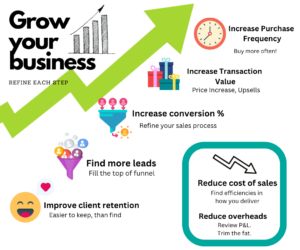How long does it take from sale to cash collection for your business?
For some, it can take anywhere from 20-60 days.
You need time to sell, create, deliver the work, and then actually invoice..before finally collecting the cash.
The cash conversion cycle of a business is often ignored or left to the accountant but owners need to realise how important it is to the health of their business and how quickly they can grow.
If you are constantly chasing for payments or struggling to have enough cash to meet payroll it can often be that the time between the sale and when you collect funds is far too long.
Let’s examine how we can get cash into your pocket as quickly as possible.
- Be Nice
The secret is obvious: make it as easy as possible for people to give you money, and be nice about it – especially when chasing.
You catch more flies with honey than with vinegar, and in this case, it is true. I’ve worked alongside many Accounts Payable teams and the rude people generally get their invoices put to the bottom of the pile.
So a direct call to clients with a friendly tone goes a long way. If it’s email then word it nicely.
If you can get a direct line into their accounting team and whoever controls payments – then do it, and perhaps send them chocolates.
Xero has an option to send Auto-reminders to clients after a certain time period but we find this fairly impersonal and not that successful in collecting. Business is about relationships, and nobody likes being chased by a robot, not even Arnie.
- Offer a range of options
You also want to offer a range of options for them to pay. Direct debit is the best to save on fees for you, but perhaps a credit card via a payment gateway like stripe is more convenient for them.
Often if your customer is having their own cash flow challenges – they won’t have the funds in their bank to pay and may need to throw it on the card.
Popular payment gateways such as Stripe and Paypal are popular to collect funds, but other options like GoCardless let them organize direct debit payments up front (bank-to-bank) which saves you fees.
- Offer a small discount
The classic is to offer a small discount for full payment upfront. Enough to entice them but not enough to erode the value of your offer.
The other option: often a payment plan, should end up being 10-15% more expensive than the upfront option.
- Define your terms and stick to them
Often you can get terms favorable to you if you set clear expectations upfront and stick to them. This needs to be defined and agreed upon in the sales process with your client.
Payment up front, in advance, is what you should aim for.
If this is not possible, at least part payment of 50% should be made before you start.
For Agencies that need to manage their client’s advertising spend you should get the client to enter their own card details for the Ad spend. If this is not possible, then payment in advance for the month ahead should be the standard.
If the upfront option is not possible, aim for 7 days after invoice, and at the very minimum 14 days after invoice.
- Improve your Invoicing System
See note above on: MAKE IT EASY.
If you have been living under a rock and are not currently using Xero to manage your accounts – then now is the time.
You can link up lots of different payment gateways to your invoice, so clients can organise payment with the click of a button, and you are notified straight away.
- Limit your damage
Bad debts are always a risk when doing business. If all of these tips have not helped and you have a bunch of invoices outstanding from a client: You need to limit your exposure ASAP.
Have a clear policy for when you stop work, e.g once total invoices outstanding go above 10k we put the tools down until it’s paid.
Remember – you need to pay your staff payroll on time no matter what. Your staff are serving that client. They no pay – you no work.
For any risky clients who you suspect are struggling ask for payment upfront in order to continue working together.
For any outstanding debts, offer them a regular payment plan in smaller amounts to get them used to paying you something (anything!) to ensure they don’t forget about it.
The squeaky wheel gets the oil so make sure to BE NICE, but be firm.
That money is used to pay your staff and feed their families – you are no good to anyone if you go broke.
Hopefully, these tips will help you lower the number of days between the sale and collection. This will ensure you have more cash on hand to reinvest in your business, pay your staff, pay down your own debts, build your savings and sleep much better at night!




